Experimental Investigation of Subject-Specific On-Body Radio Propagation Channels for Body-Centric Wireless Communications
Abstract
:1. Introduction
2. Narrowband Subject-Specific On-Body Radio Propagation Channel Characterisation
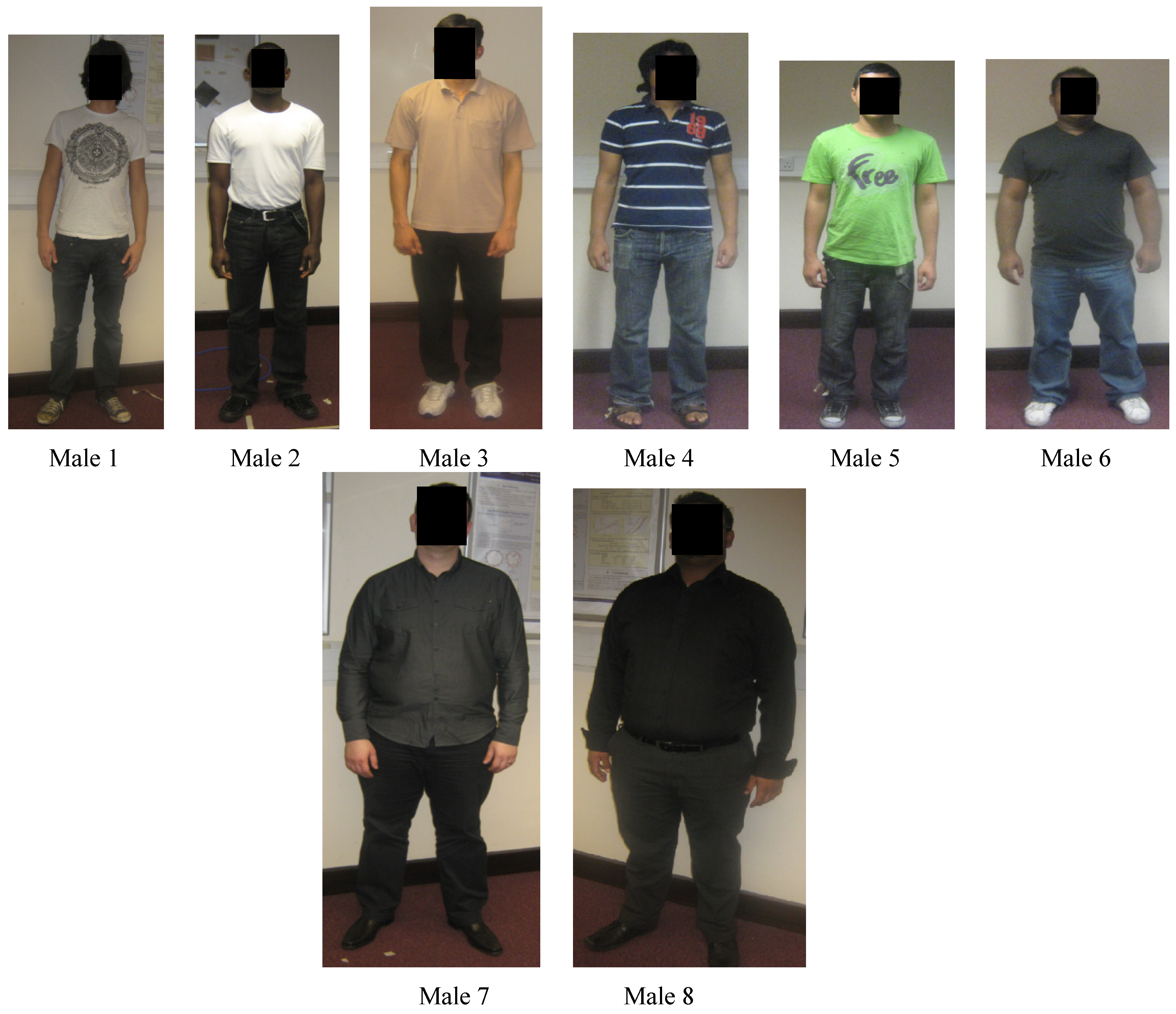
| Dimensions | Male 1 | Male 2 | Male 3 | Male 4 | Male 5 | Male 6 | Male 7 | Male 8 |
|---|---|---|---|---|---|---|---|---|
| Height (cm) | 182 | 181 | 186 | 178 | 169 | 168 | 188 | 180 |
| Weight (kg) | 70 | 73 | 74 | 78 | 68 | 91 | 120 | 128 |
| Chest Circumference (cm) | 87 | 91 | 92 | 93 | 94 | 114 | 124 | 136 |
| Waist Circumference (cm) | 79 | 81 | 82 | 86 | 89 | 96 | 130 | 140 |
2.1. Measurement Settings
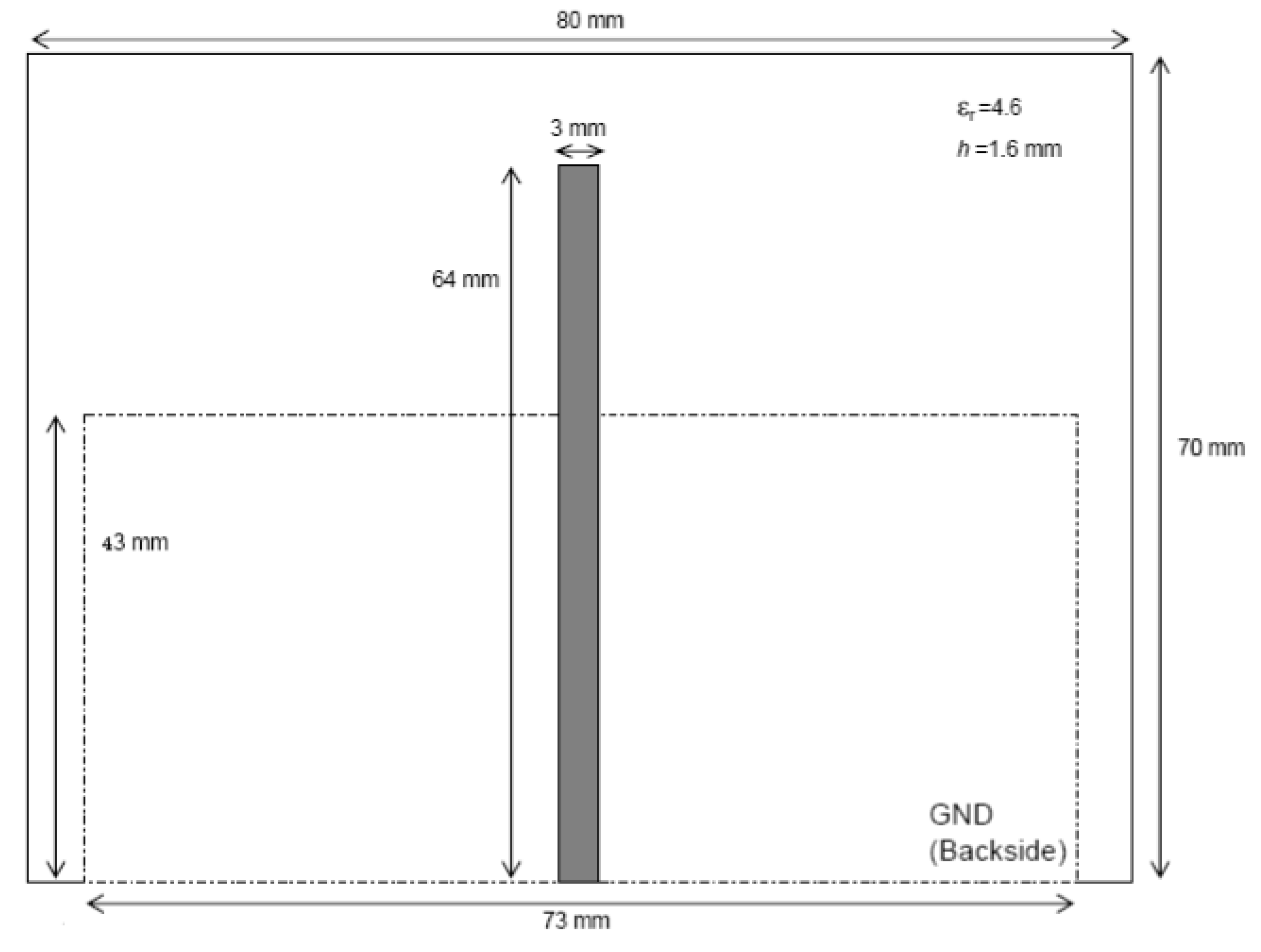
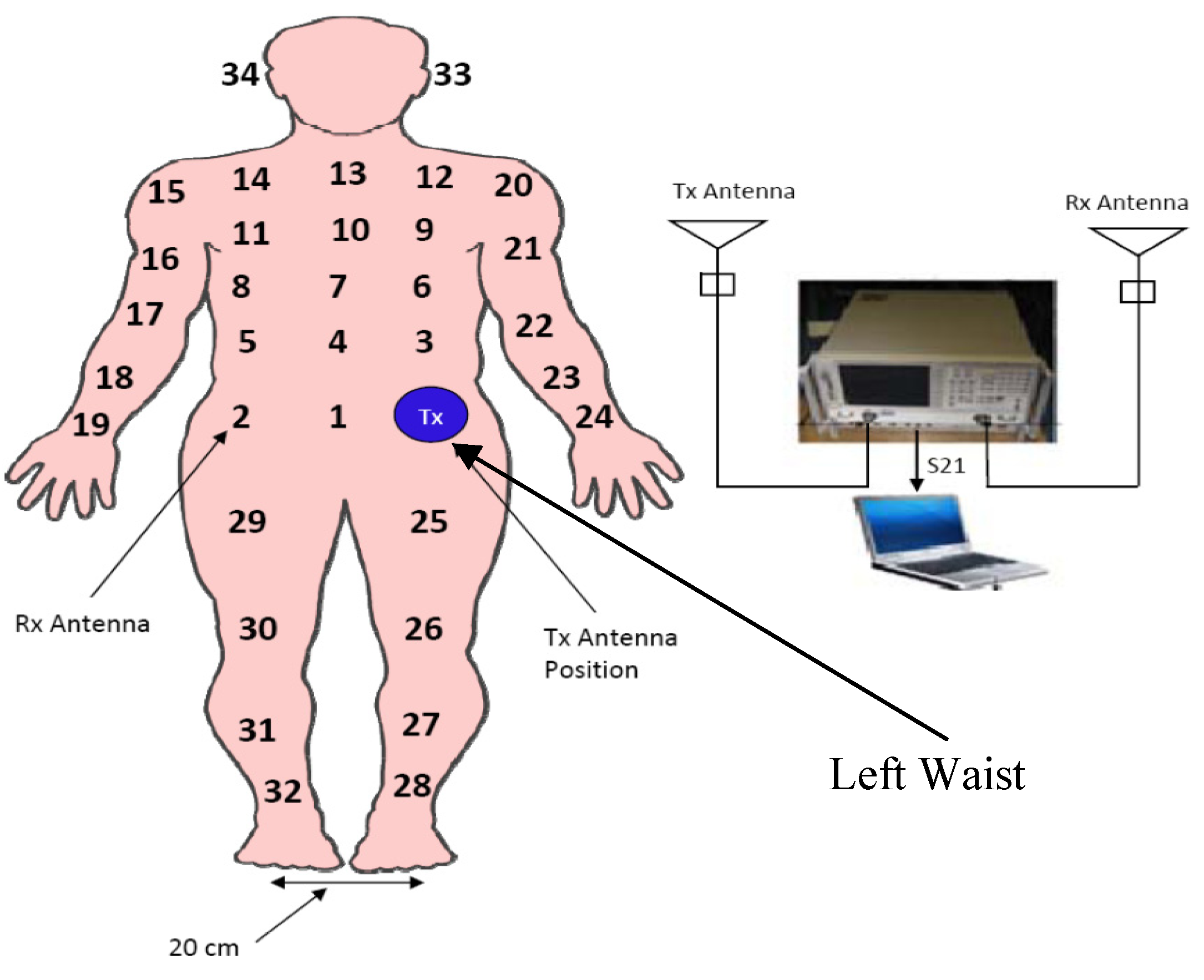
2.2. Narrowband On-Body Path Loss Characterisation

| Path Loss Parameters | Male 1 | Male 2 | Male 3 | Male 4 | Male 5 | Male 6 | Male 7 | Male 8 |
|---|---|---|---|---|---|---|---|---|
| γ | 3.20 | 3.25 | 3.31 | 3.39 | 3.48 | 3.71 | 3.85 | 4.05 |
| PLdB(d0) (dB) | 41.0 | 40.8 | 40.7 | 43.8 | 42.0 | 42.8 | 44.2 | 41.7 |
| σ (dB) | 7.62 | 6.80 | 7.12 | 6.31 | 8.01 | 7.09 | 7.17 | 8.12 |
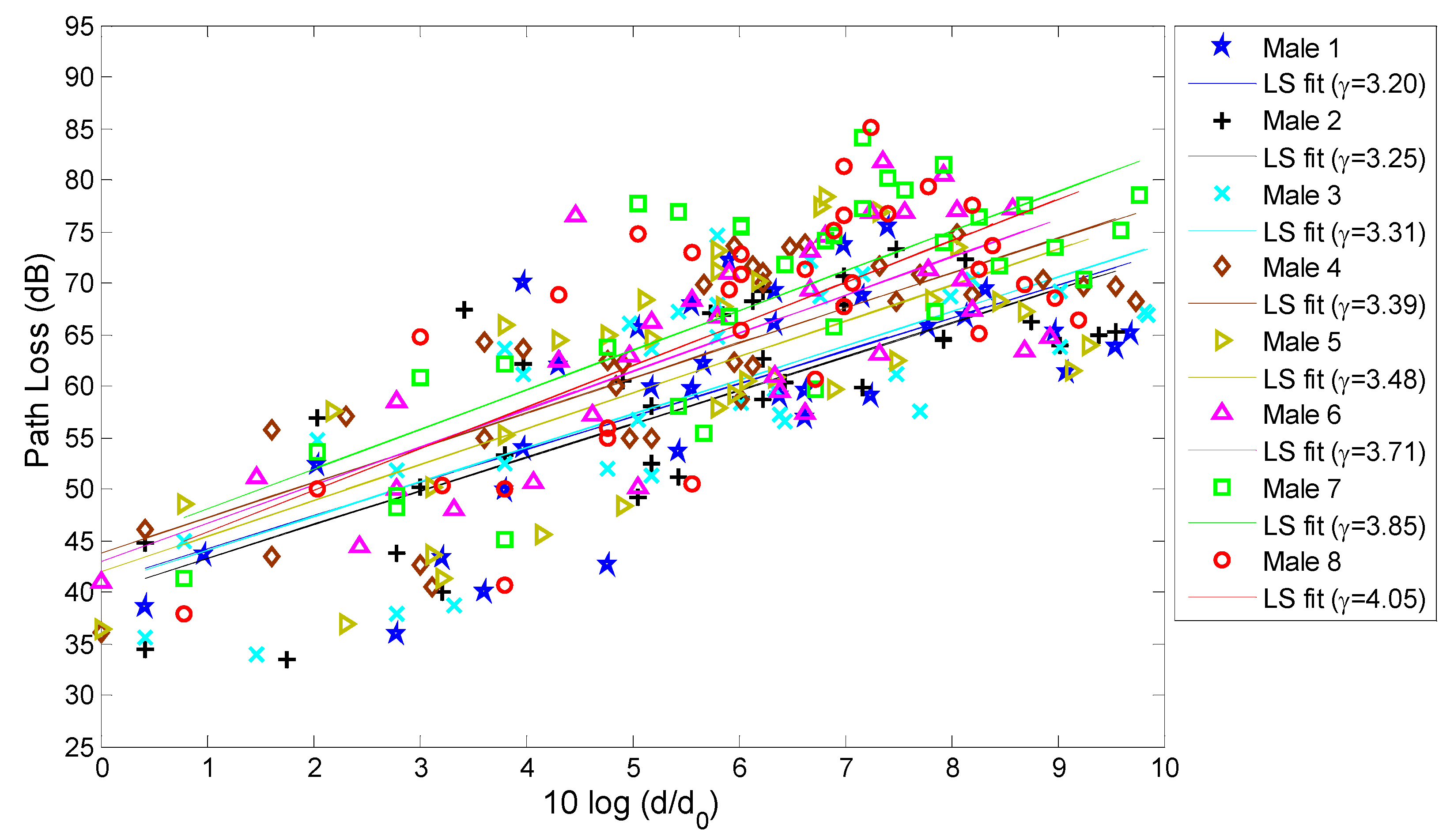
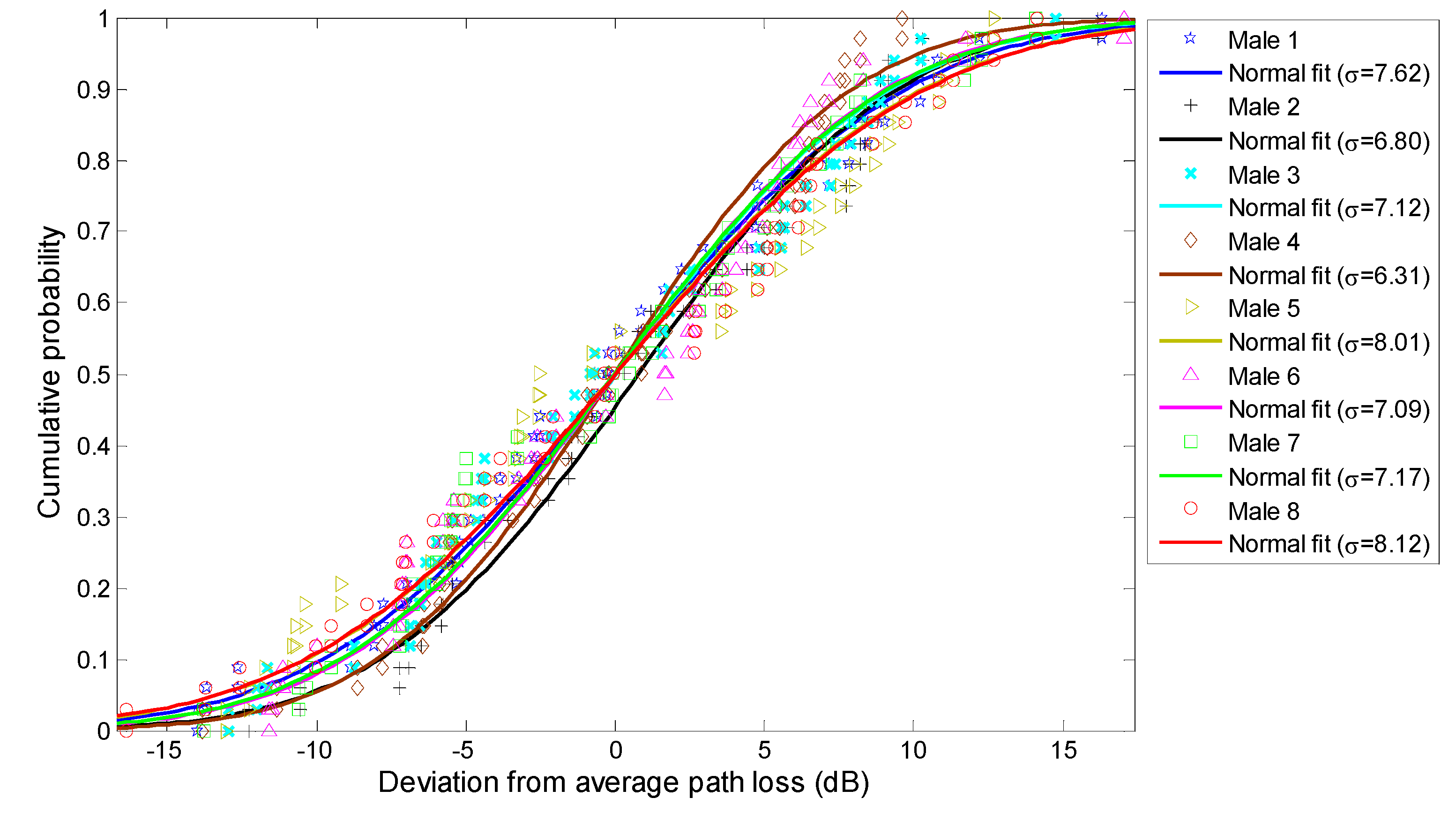

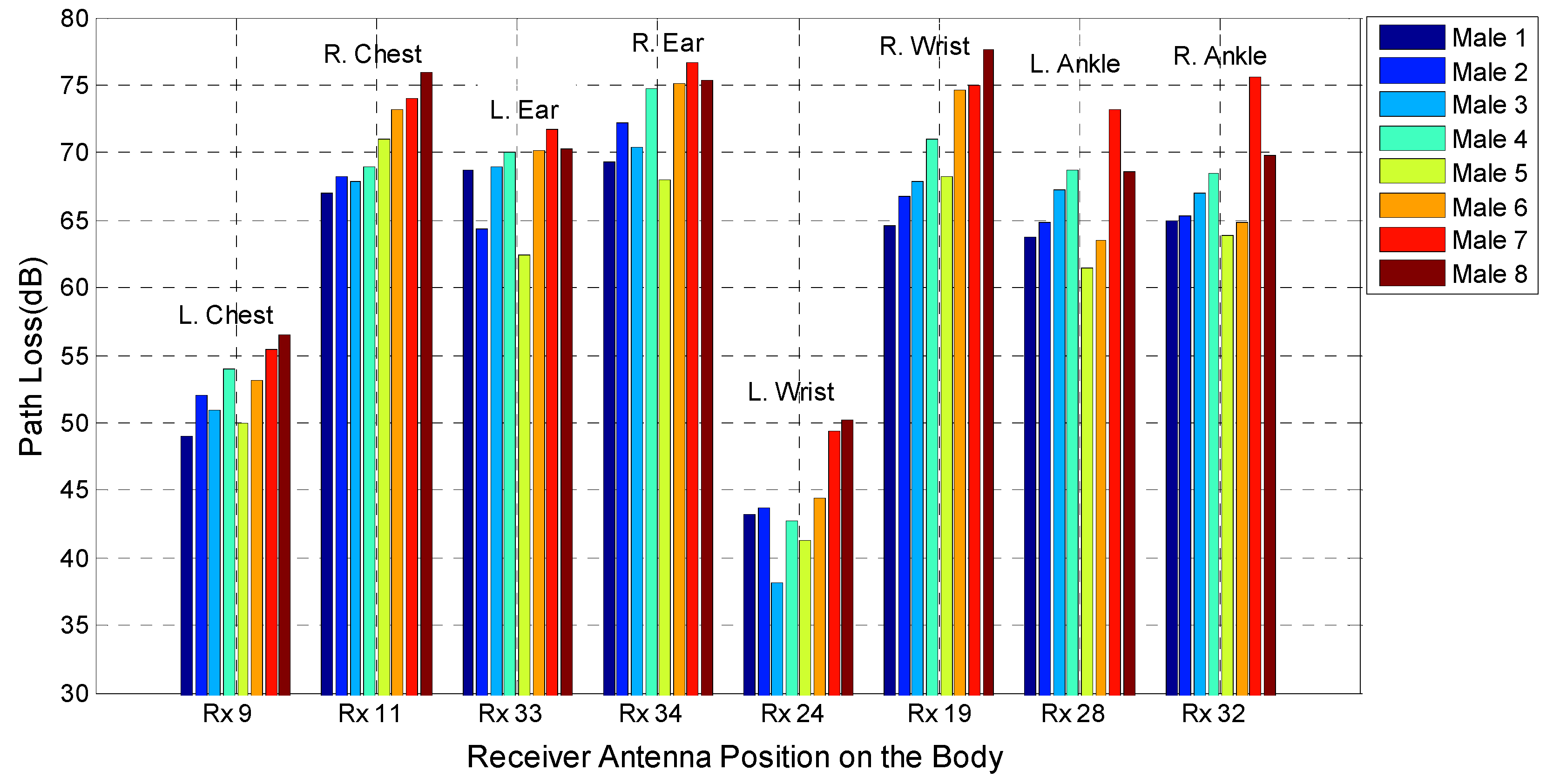
| Channel | Maximum Path Loss (dB) Variation |
|---|---|
| Left chest | 7.52 |
| Right chest | 8.95 |
| Left ear | 9.25 |
| Right ear | 8.64 |
| Left wrist | 12.10 |
| Right wrist | 13.02 |
| Left ankle | 11.79 |
| Right ankle | 11.69 |
3. Ultra-Wideband (UWB) Subject-Specific On-Body Radio Propagation Channel Characterisation
3.1. Measurement Settings
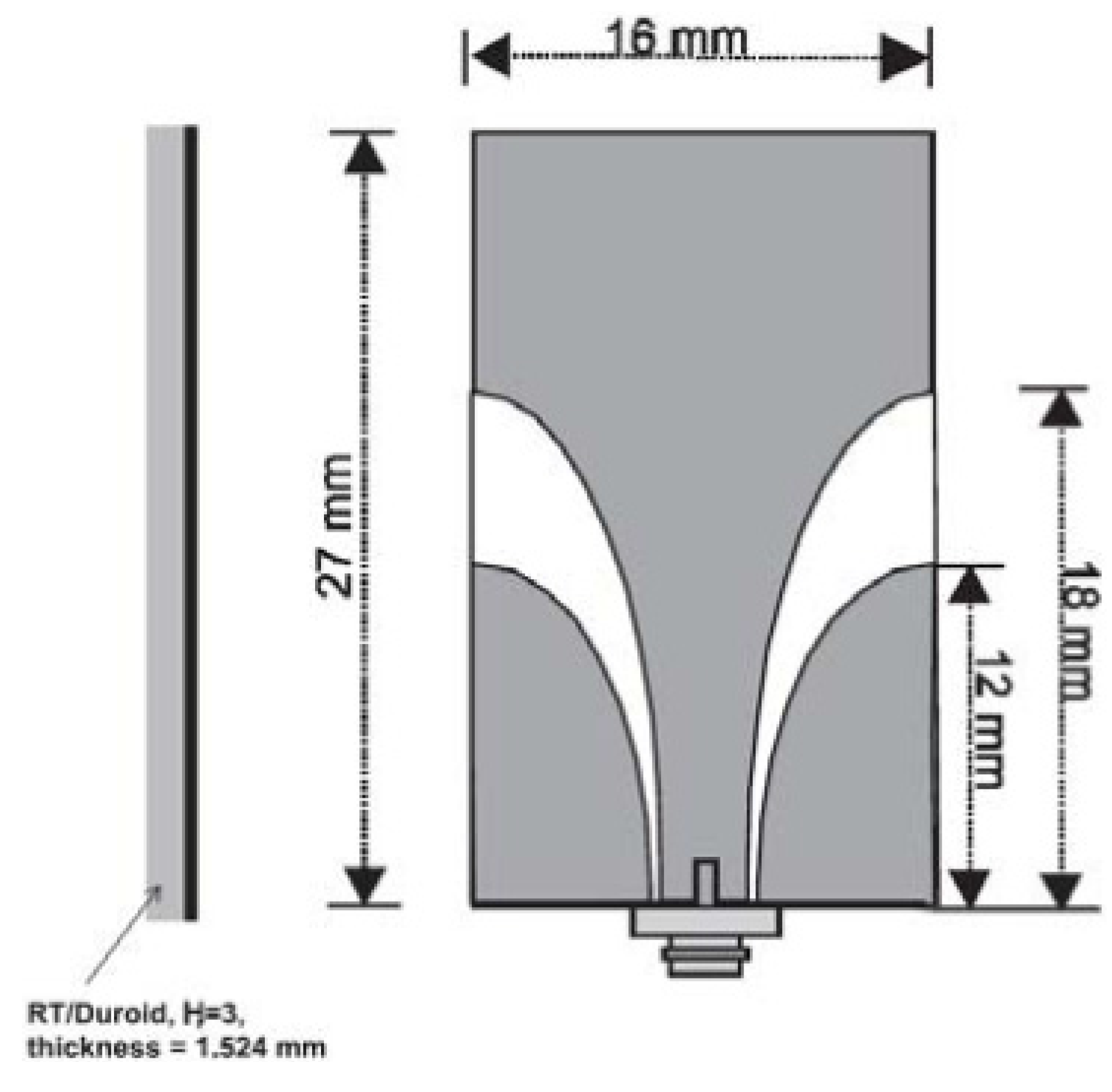
3.2. UWB On-Body Path Loss Characterisation
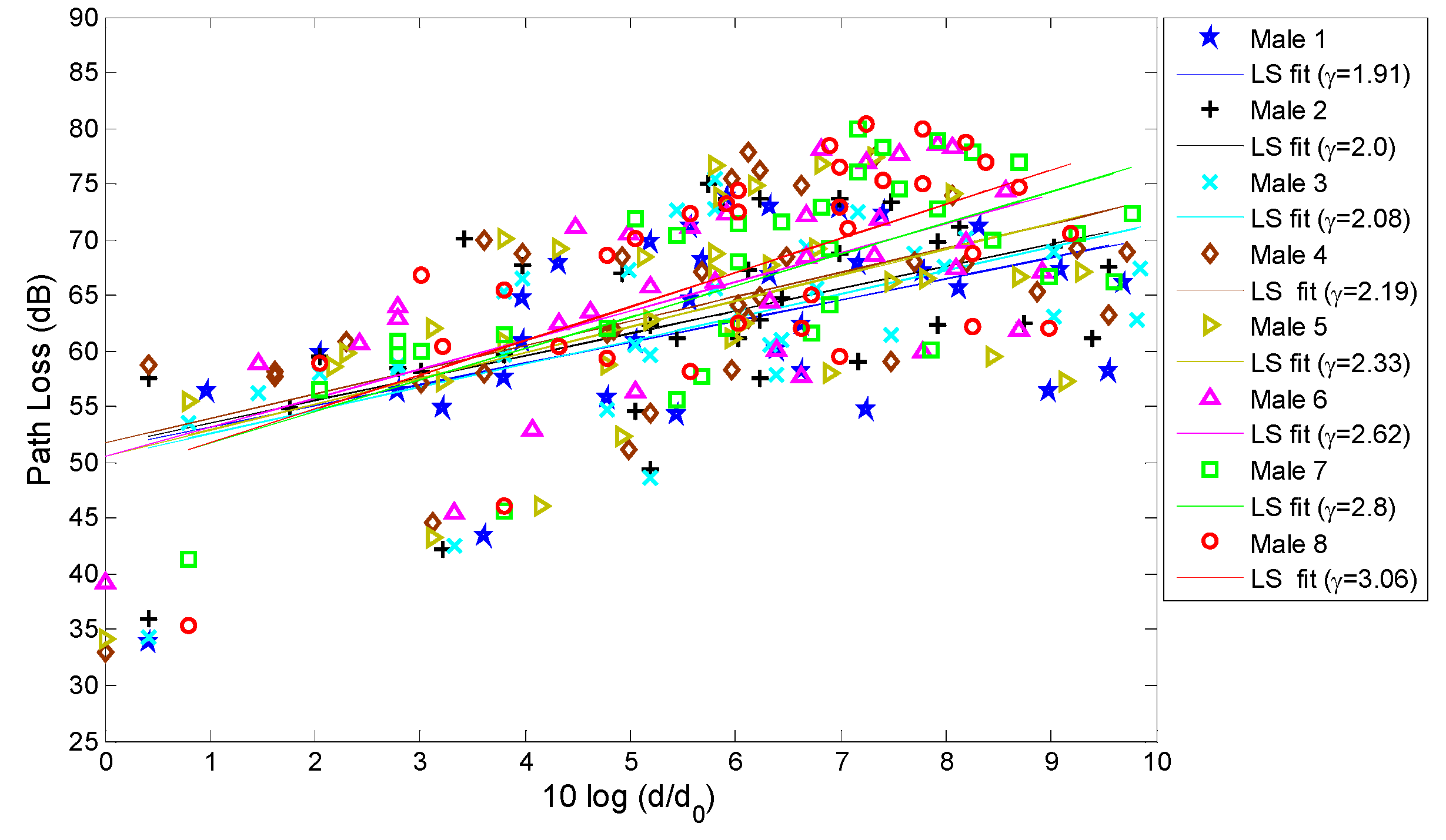

| Path Loss Parameters | Male 1 | Male 2 | Male 3 | Male 4 | Male 5 | Male 6 | Male 7 | Male 8 |
|---|---|---|---|---|---|---|---|---|
| γ | 1.91 | 2.0 | 2.08 | 2.19 | 2.33 | 2.62 | 2.8 | 3.06 |
| PLdB(d0) | 51.2 | 51.6 | 50.4 | 51.8 | 50.7 | 50.5 | 49.0 | 48.7 |
| σ | 7.36 | 7.27 | 6.90 | 7.61 | 8.30 | 6.86 | 6.60 | 7.80 |
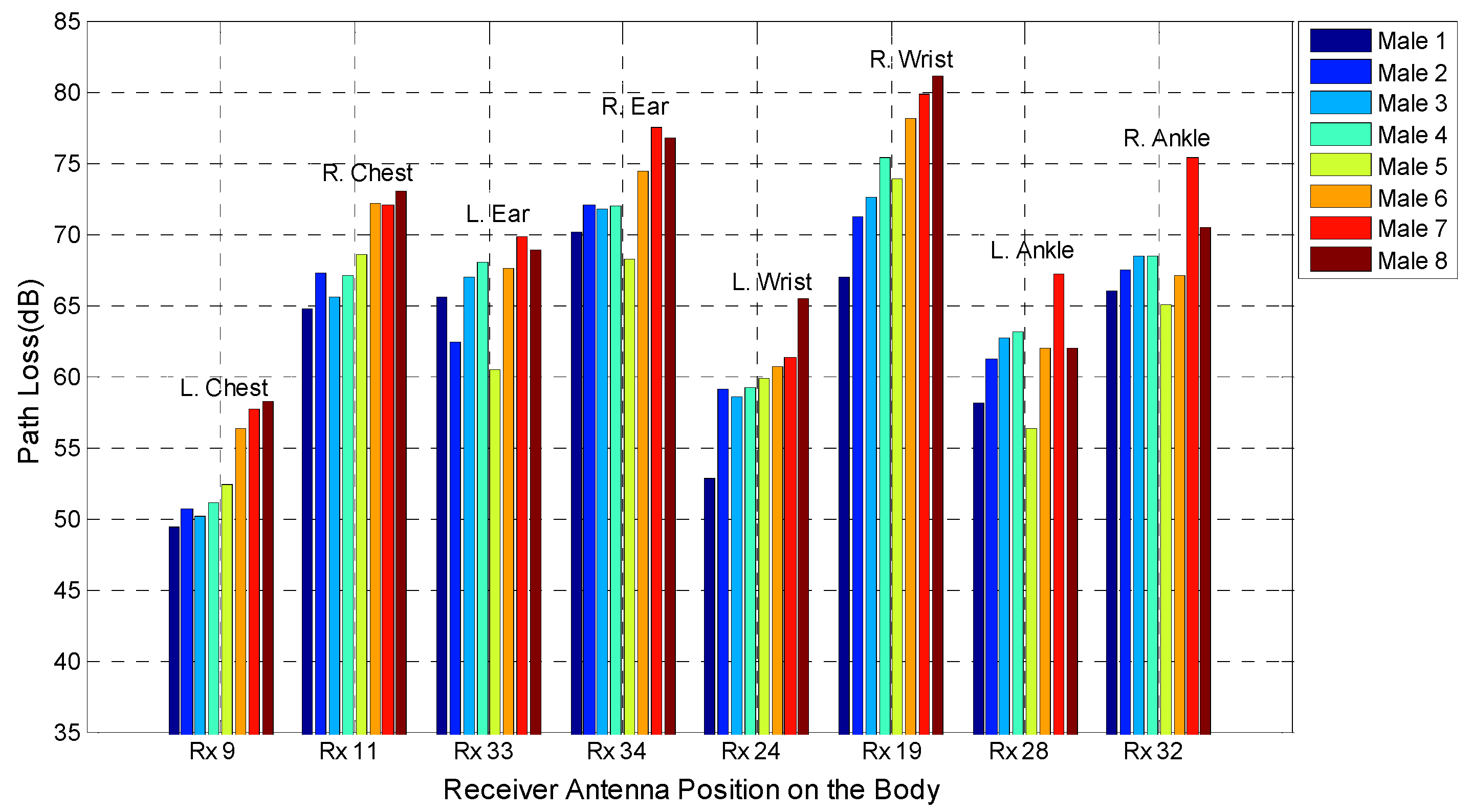
| Channel | Maximum path loss (dB) variation |
|---|---|
| Left chest | 8.8 |
| Right chest | 8.24 |
| Left ear | 9.4 |
| Right ear | 9.28 |
| Left wrist | 12.62 |
| Right wrist | 14.21 |
| Left ankle | 10.89 |
| Right ankle | 10.29 |
4. Narrowband vs. Ultra-Wideband Subject-Specific On-Body Radio Propagation Channels
- For the narrowband case at 2.45 GHz, the path loss exponent is in the range of 3.20 to 4.05, while for the UWB (3–10 GHz) case, it is in the range of 1.91 to 3.06.
- It is noted that, for the narrowband on-body radio propagation case, due to the different sizes, shapes and heights of the test subjects, the path loss exponent value varies up to a maximum of 0.85. For the UWB case, for different subjects, the path loss exponent value varies up to a maximum of 1.15. From this study, it is observed that, for different test subjects, the ultra-wideband system shows a higher variation of the path loss exponent value (0.3). The maximum path loss exponent variation for different test subjects in the UWB case is very close to the narrowband system. Table 6 summarises the dimensions and narrowband and UWB path loss exponents of the eight test subjects.
- For the eight different on-body links considered, for different test subjects, a maximum of 13.02 dB of variation in path loss value of an on-body radio channel (left waist to right wrist) is noticed for the narrowband system, while for the UWB system, it is noticed to be 14.21 dB. For the UWB case, nearly the same trends are noticed as was observed for the narrowband case.
- The values of path loss exponents γ are found to be higher for the narrowband case than the ones found for the UWB system. In the narrowband case, there is only one frequency band of operation (2.45 GHz), which has fewer effects (reflection, diffraction, scattering and so on) from the indoor environments and human body parts. On the other hand, in the UWB case, there are many frequency components (3–10 GHz) that have more effects from indoor environments and human body parts, resulting in a lower path loss exponent, as compared with the narrowband case. UWB technology is highly robust in multipathing; hence, the path loss value is lower at a higher distance, resulting in a lower path loss exponent.
- At the reference distance, the path loss value is found to be higher for the UWB on-body radio channel (average, 8 dB) compared with the narrowband system. At lower communication distances between the Tx and Rx, the path loss value for UWB on-body radio channels is found to be higher compared with the narrowband case (such as the left wrist and left chest links).
| Dimensions and path loss exponents | Male 1 | Male 2 | Male 3 | Male 4 | Male 5 | Male 6 | Male 7 | Male 8 |
|---|---|---|---|---|---|---|---|---|
| Height (cm) | 182 | 181 | 186 | 178 | 169 | 168 | 188 | 180 |
| Chest circumference (cm) | 87 | 91 | 92 | 93 | 94 | 114 | 124 | 136 |
| Waist circumference (cm) | 79 | 81 | 82 | 86 | 89 | 96 | 130 | 140 |
| Weight (kg) | 70 | 73 | 74 | 78 | 68 | 91 | 120 | 128 |
| Path loss exponents (γ) for the narrowband system at 2.45 GHz | 3.20 | 3.25 | 3.31 | 3.39 | 3.48 | 3.71 | 3.85 | 4.05 |
| Path loss exponents (γ) for the UWB system at 3–10 GHz | 1.91 | 2.0 | 2.08 | 2.19 | 2.33 | 2.62 | 2.8 | 3.06 |
5. Conclusions
Acknowledgments
Conflicts of Interest
References
- Hall, P.S.; Hao, Y. Antennas and propagation for Body-Centric Wireless Communications. Antenn. Propag. 2006. [Google Scholar] [CrossRef]
- Fort, A.; Desset, C.; Doncker, P.D.; Biesen, L.V. Ultra wideband body area propagation: From statistics to implementation. IEEE Trans. Microw. Theory Tech. 2006, 54, 1820–1826. [Google Scholar] [CrossRef]
- Drude, S. Requirements and application scenarios for body area networks. In Proceedings of the 16th IST Mobile and Wireless Communications Summit; Budapest, Hungary: 1–5 July 2007.
- Bernhard, J.; Nagel, P.; Hupp, J.; Strauss, W.; von der Grun, T. BAN-body area network for wearable computing. In Proceedings of the 9th Wireless World Research Forum Meeting, Zurich, Switzerland, 1–2 July 2003.
- Jovanov, E.; O’Donnell Lords, A.; Raskovic, D.; Cox, P.; Adhami, R.; Andrasik, F. Stress monitoring using a distributed wireless intelligent sensor system. IEEE Eng. Med. Biol. Mag. 2003, 22, 49–55. [Google Scholar]
- Timmons, N.F.; Scanlon, W.G. Analysis of the performance of IEEE 802.15.4 for medical sensor body area networking. In Proceedings of the 1st Annual IEEE Communications Conference Sensor and Ad Hoc Communications and Networks (SECON), Santa Clara, CA, USA, 4–7 October 2004; pp. 16–24.
- Alomainy, A.; Hao, Y.; Owadally, A.; Parini, C.G.; Nechayev, Y.; Constantinou, C.C.; Hall, P.S. Statistical analysis and performance evaluation for on-body radio propagation with microstrip patch antenna. IEEE Trans. Antenn. Propag. 2007, 55, 245–248. [Google Scholar]
- Nechayev, Y.; Hall, P.; Constantinou, C.C.; Hao, Y.; Owadally, A.; Parini, C.G. Path loss measurements of on-body propagation channels. In Proceedings of the International Symposium on Antennas and Propagation, Sendai, Japan, 17–21 August 2004; pp. 745–748.
- Hall, P.S.; Nechayev, Y.; Hao, Y.; Alomainy, A.; Kamaruddin, M.R.; Constantinou, C.C.; Dubrovka, R.; Parini, C.G. Radio characterisation and antennas for on-body communications. In Proceedings of the Loughborough Antennas and Propagation Conference, Loughborough, UK, 4–6 April 2005; pp. 330–333.
- Hao, Y.; Alomainy, A.; Hall, P.S.; Nechayev, Y.I.; Parini, C.G.; Constantinou, C.C. Antennas and propagation for body-centric wireless communications. In Proceedings of the IEEE/ACES International Conference on Wireless Communications and Applied Computational Electromagnetics, Honolulu, HI, USA, 3–7 April 2005.
- Hu, Z.; Nechayev, Y.; Hall, P.S.; Constantinou, C.; Hao, Y. Measurements and statistical analysis of on-body channel fading at 2.45 GHz. IEEE Antenn. Wirel. Propag. Lett. 2007, 6, 612–615. [Google Scholar]
- Rahim, H.A.; Malek, F.; Hisham, N.; Malek, M.F.A. Statistical analysis of on-body radio propagation channel for body-centric wireless communications. In Proceedings of the PIERS, Stockholm, Sweden, 12–15 August 2013.
- Cotton, S.L.; Conway, G.A.; Scanlon, W.G. A time-domain approach to the analysis and modeling of on-body propagation characteristics using synchronized measurements at 2.45 GHz. IEEE Trans. Antenn. Propag. 2009, 57, 943–955. [Google Scholar] [CrossRef]
- Cotton, S.L.; Scanlon, W.G. An experimental investigation into the influence of user state and environment on fading characteristics in wireless body area networks at 2.45 GHz. IEEE Trans. Wirel. Commun. 2009, 8, 6–12. [Google Scholar] [CrossRef]
- Alomainy, A.A.; Hao, Y.; Parini, C.G.; Hall, P.S. Comparison between two different antennas for UWB on-body propagation measurements. IEEE Antennas Wirel. Propag. Lett. 2005, 4, 31–34. [Google Scholar] [CrossRef]
- Sani, A.; Hao, Y. Modeling of path loss for ultrawide band body-centric wireless communications. In Proceedings of the International Conference on Electromagnetics in Advance Applications (ICEAA), Torino, Italy, 14–18 September 2009; pp. 998–1001.
- Fort, A.; Desset, C.; Ryckaert, J.; Donker, P.D.; Biesen, L.V.; Wambackq, P. Characterization of ultra wideband body area propagation channel. In Proceedings of the International Conference on Ultra Wideband, Zurich, Switzerland, 5–8 September 2005.
- Wang, Q.; Wang, J. Performances of on-body chest-to-waist UWB communication link. IEEE Microw. Wirel. Compon. Lett. 2009, 19, 119–121. [Google Scholar] [CrossRef]
- Zasowski, T.; Althaus, F.; Stager, M.; Wittneben, A.; Troster, G. UWB for non-invasive wireless body area networks: Channel measurements and results. In Proceedings of the IEEE Conference on Ultra Wideband Systems and Technologies, Reston, VA, USA, 16–19 November 2003.
- Alomainy, A.; Hao, Y.; Hu, X.; Parini, C.G.; Hall, P.S. UWB on-body radio propagation and system modeling for wireless body-centric networks. IEE Proc. Commun. 2006, 153, 107–114. [Google Scholar] [CrossRef]
- Abbasi, Q.H.; Sani, A.; Alomainy, A.; Hao, Y. Radio channel characterization and system-level modeling for multiband OFDM ultra wideband body-centric wireless networks. IEEE Trans. Microw. Theory Tech. 2010, 58, 3485–3492. [Google Scholar]
- Sani, A.; Palikaras, G.; Alomainy, A.; Hao, Y. Time domain UWB radio channel characterisation for body-centric wireless communications in indoor environment. In Proceedings of the IET Seminar on Wideband and Ultrawide-band Systems and Technologies: Evaluating Current Research Development, London, UK, 6 November 2008.
- Sani, A.; Alomainy, A.; Hao, Y. Effect of the indoor environment on the UWB on-body radio propagation channel. In Proceedings of the 3rd European Conference on Antennas and Propagation (EuCAP), Berlin, Germany, 23–27 March 2009; pp. 455–458.
- Khan, M.M.; Abbasi, Q.H.; Alomainy, A.; Hao, Y. Performance of ultrawideband wireless tags for on-body radio channel characterization. Int. J. Antenn. Propag. 2012. [Google Scholar] [CrossRef]
- Abbasi, Q.H.; Alomainy, A.; Hao, Y. Experimental investigation of ultra wideband diversity techniques for antennas and radio propagation in body-centric wireless communications. Prog. Electromagn. Res. C 2013, 34, 165–181. [Google Scholar] [CrossRef]
- Khan, M.M.; Abbasi, Q.H.; Liaqat, S.; Alomainy, A. Comparison of two measurement techniques for UWB off-body radio channel characterisation. Prog. Electromagn. Res. M 2012, 27, 179–189. [Google Scholar] [CrossRef]
- Maskooki, A.; Soh, C.B.; Gunawan, E.; Low, K.S. Ultra-wideband real-time dynamic channel characterization and system-level modeling for radio links in body area networks. IEEE Trans. Microw. Theory Tech. 2013, 61, 2995–3004. [Google Scholar] [CrossRef]
- Khan, M.M.; Abbasi, Q.H.; Hossain, N.; Afroze, R.; Masud, A.A. On-body radio channel measurements for three different human body sizes. In Proceedings of the 15th International Conference on Computer and Information Technology (ICCIT), Chittagong, Bangladesh, 22–24 December 2012; pp. 230–234.
- Abbasi, Q.H.; Sani, A.; Alomainy, A.; Hao, Y. Numerical characterisation and modelling subject-specific ultra wideband body-centric radio channels and systems for healthcare applications. IEEE Trans. Inf. Technol. Biomed. 2012, 16, 221–227. [Google Scholar] [CrossRef]
- Zhao, Y.; Sani, A.; Hao, Y.; Lee, S.L.; Yang, G.Z. A simulation environment for subject-specific radio channel modeling in wireless body sensor networks. In Proceedings of the Sixth International Workshop on Wearable and Implantable Body Sensor Networks(BSN), Berkeley, CA, USA, 3–5 June 2009; pp. 23–28.
- Suma, M.N.; Bybi, P.C.; Mohanan, P. A wideband printed monopole antenna for 2.45 GHz WLAN applications. Microw. Opt. Technol. Lett. 2006, 48, 871–873. [Google Scholar] [CrossRef]
- Gassemzadeh, S.S.; Jana, R.; Rice, C.W.; Turin, W.; Tarohk, V. A statistical path loss model for in-home UWB channels. In Proceedings of the IEEE Conference Ultrawide Band Systems and Technologies, Baltimore, MD, USA, 21–23 May2002; pp. 59–64.
- Rahman, A.; Hao, Y. A novel tapered slot CPW-fed antenna for ultra-wideband applications and its on/off body performance. In Proceedings of the International Workshop on Antenna Technology, (IWAT), Cambridge, UK, 21–23 March 2007.
© 2014 by the authors; licensee MDPI, Basel, Switzerland. This article is an open access article distributed under the terms and conditions of the Creative Commons Attribution license (http://creativecommons.org/licenses/by/3.0/).
Share and Cite
Khan, M.M.; Abbasi, Q.H.; Alomainy, A.; Parini, C. Experimental Investigation of Subject-Specific On-Body Radio Propagation Channels for Body-Centric Wireless Communications. Electronics 2014, 3, 26-42. https://doi.org/10.3390/electronics3010026
Khan MM, Abbasi QH, Alomainy A, Parini C. Experimental Investigation of Subject-Specific On-Body Radio Propagation Channels for Body-Centric Wireless Communications. Electronics. 2014; 3(1):26-42. https://doi.org/10.3390/electronics3010026
Chicago/Turabian StyleKhan, Mohammad Monirujjaman, Qammer Hussain Abbasi, Akram Alomainy, and Clive Parini. 2014. "Experimental Investigation of Subject-Specific On-Body Radio Propagation Channels for Body-Centric Wireless Communications" Electronics 3, no. 1: 26-42. https://doi.org/10.3390/electronics3010026
APA StyleKhan, M. M., Abbasi, Q. H., Alomainy, A., & Parini, C. (2014). Experimental Investigation of Subject-Specific On-Body Radio Propagation Channels for Body-Centric Wireless Communications. Electronics, 3(1), 26-42. https://doi.org/10.3390/electronics3010026





